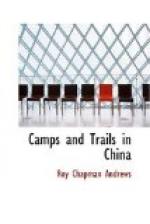He went with us on a pack mule to Bhamo, down the Irawadi River to Rangoon, and across the Bay of Bengal to Calcutta. He then visited many cities in India, and at Bombay boarded the P. & O.S.S. Namur for Hongkong and became the pet of the ship. From China we took him to Japan, across the Pacific to Vancouver, and finally to our home at Lawrence Park, Bronxville, New York. After an adventurous career as a house pet, when his exploits had made him famous and ourselves disliked by all the neighbors, we regretfully sent him to the National Zooelogical Park, Washington, D.C., where he is living happily at the present time. He was the most delightful little pet we have ever owned and, although now he is nearly a full grown bear, his early life is perpetuated in motion pictures and we can see him still as he came to us the first week. He might well have been the model for the original “Teddy Bear” for he was a round ball of fur, mostly head and ears and sparkling little eyes.
CHAPTER XXXVI
A BIG GAME PARADISE
A few months previous to our arrival, Mr. Abertsen had discovered a splendid hunting ground near the village of Hui-yao, about eighty li from Teng-yueh. He had been shooting rabbits and pheasants and, while passing through the village, the natives told him that a large herd of gnai-yang or “wild goats” lived on the side of a hill through which a branch of the Shweli River had cut a deep gorge.
Although Abertsen was decidedly skeptical as to the accuracy of the report he spent two days hunting and with his shotgun killed two gorals; moreover, he saw twenty-five others. We examined the two skins and realized at once that they represented a different species from those of the Snow Mountain. Therefore, when we left Teng-yueh our first camp was at Hui-yao.
Heller and I started with four natives shortly after daylight. We crossed a tumbledown wooden bridge over the river at a narrow canon where the sides were straight walls of rock, and followed down the gorge for about two miles. On the way Heller, who was in front, saw two muntjac standing in the grass on an open hillside, and shot the leader. The deer pitched headlong but got to its feet in a few moments and struggled off into the thick cover at the edge of the meadow. It had disappeared before Heller reached the clearing but he saw the second deer, a fine doe, standing on a rock. Although his bullet passed through both lungs the animal ran a quarter of a mile, and he finally discovered her several hours later in the bushes beside the river.
In a short time we reached an open hillside which rose six or seven hundred feet above the river in a steep slope; the opposite side was a sheer wall of rock bordered on the rim by an open pine forest. We separated at this point. Heller, with two natives, keeping near the river, while I climbed up the hill to work along the cliffs half way to the summit.




